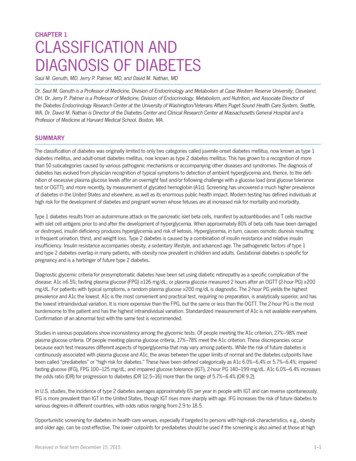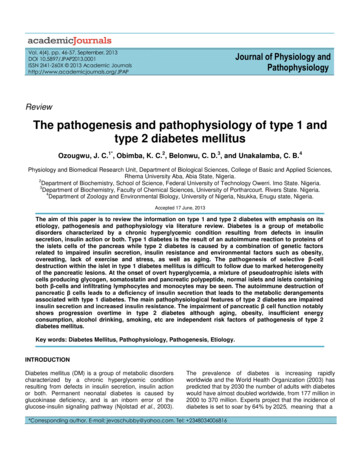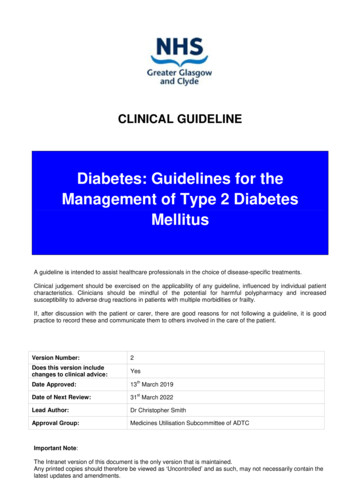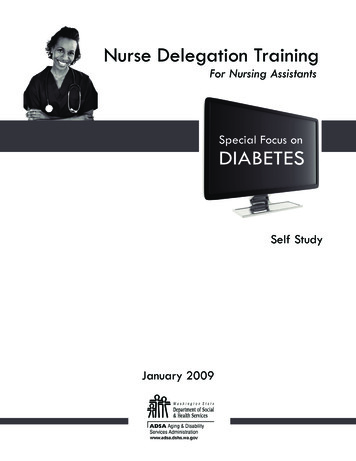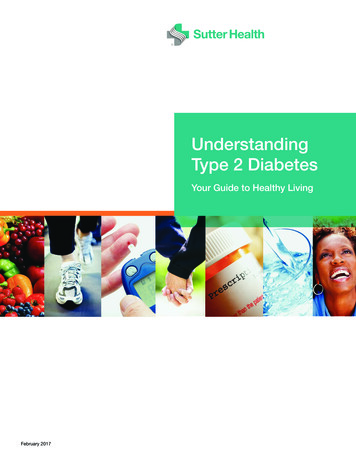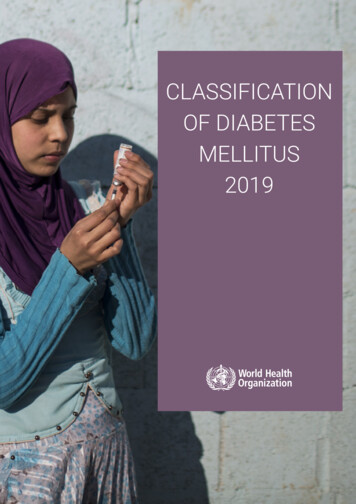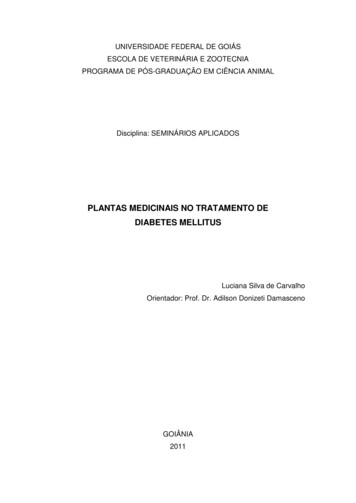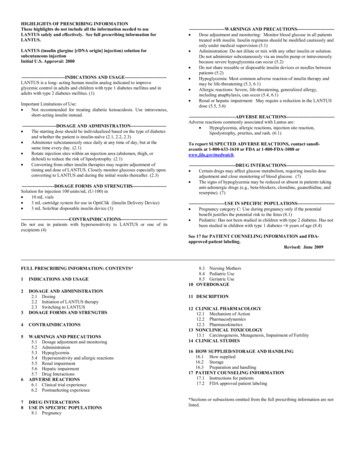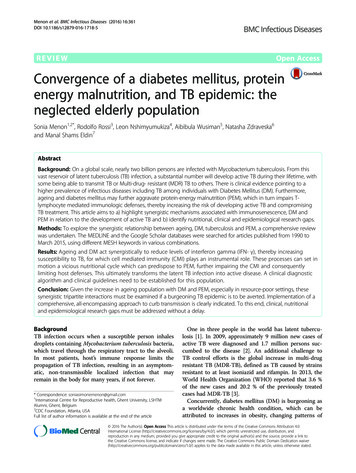
Transcription
Menon et al. BMC Infectious Diseases (2016) 16:361DOI 10.1186/s12879-016-1718-5REVIEWOpen AccessConvergence of a diabetes mellitus, proteinenergy malnutrition, and TB epidemic: theneglected elderly populationSonia Menon1,2*, Rodolfo Rossi3, Leon Nshimyumukiza4, Aibibula Wusiman5, Natasha Zdraveska6and Manal Shams Eldin7AbstractBackground: On a global scale, nearly two billion persons are infected with Mycobacterium tuberculosis. From thisvast reservoir of latent tuberculosis (TB) infection, a substantial number will develop active TB during their lifetime, withsome being able to transmit TB or Multi-drug- resistant (MDR) TB to others. There is clinical evidence pointing to ahigher prevalence of infectious diseases including TB among individuals with Diabetes Mellitus (DM). Furthermore,ageing and diabetes mellitus may further aggravate protein-energy malnutrition (PEM), which in turn impairs Tlymphocyte mediated immunologic defenses, thereby increasing the risk of developing active TB and compromisingTB treatment. This article aims to a) highlight synergistic mechanisms associated with immunosenescence, DM andPEM in relation to the development of active TB and b) identify nutritional, clinical and epidemiological research gaps.Methods: To explore the synergistic relationship between ageing, DM, tuberculosis and PEM, a comprehensive reviewwas undertaken. The MEDLINE and the Google Scholar databases were searched for articles published from 1990 toMarch 2015, using different MESH keywords in various combinations.Results: Ageing and DM act synergistically to reduce levels of interferon gamma (IFN- γ), thereby increasingsusceptibility to TB, for which cell mediated immunity (CMI) plays an instrumental role. These processes can set inmotion a vicious nutritional cycle which can predispose to PEM, further impairing the CMI and consequentlylimiting host defenses. This ultimately transforms the latent TB infection into active disease. A clinical diagnosticalgorithm and clinical guidelines need to be established for this population.Conclusion: Given the increase in ageing population with DM and PEM, especially in resource-poor settings, thesesynergistic tripartite interactions must be examined if a burgeoning TB epidemic is to be averted. Implementation of acomprehensive, all-encompassing approach to curb transmission is clearly indicated. To this end, clinical, nutritionaland epidemiological research gaps must be addressed without a delay.BackgroundTB infection occurs when a susceptible person inhalesdroplets containing Mycobacterium tuberculosis bacteria,which travel through the respiratory tract to the alveoli.In most patients, host’s immune response limits thepropagation of TB infection, resulting in an asymptomatic, non-transmissible localized infection that mayremain in the body for many years, if not forever.* Correspondence: soniasimonemenon@gmail.com1International Centre for Reproductive health, Ghent University, LSHTMAlumni, Ghent, Belgium2CDC Foundation, Atlanta, USAFull list of author information is available at the end of the articleOne in three people in the world has latent tuberculosis [1]. In 2009, approximately 9 million new cases ofactive TB were diagnosed and 1.7 million persons succumbed to the disease [2]. An additional challenge toTB control efforts is the global increase in multi-drugresistant TB (MDR-TB), defined as TB caused by strainsresistant to at least isoniazid and rifampin. In 2013, theWorld Health Organization (WHO) reported that 3.6 %of the new cases and 20.2 % of the previously treatedcases had MDR-TB [3].Concurrently, diabetes mellitus (DM) is burgeoning asa worldwide chronic health condition, which can beattributed to increases in obesity, changing patterns of 2016 The Author(s). Open Access This article is distributed under the terms of the Creative Commons Attribution 4.0International License (http://creativecommons.org/licenses/by/4.0/), which permits unrestricted use, distribution, andreproduction in any medium, provided you give appropriate credit to the original author(s) and the source, provide a link tothe Creative Commons license, and indicate if changes were made. The Creative Commons Public Domain Dedication o/1.0/) applies to the data made available in this article, unless otherwise stated.
Menon et al. BMC Infectious Diseases (2016) 16:361diet and physical activity as well as ageing [4, 5]. According to WHO estimates, there are currently 347 millionpeople worldwide affected by DM, [6] and by 2030 itsprevalence is projected to increase by 50 % [6]. 3/4 ofdiabetic patients live in low-income countries [7–9]. It isnow well-established that cellular immune responsesmediated by T cells and macrophages play a major rolein the defense against TB [10]. In particular, the Th1cytokine interferon (IFN)-γ is considered a principal mediator of protective immunity against TB [11, 12]DM is a clinical syndrome associated with deficiencyof insulin secretion or resistance to its actions. Apartfrom the classical micro and macrovascular complications of the disease, DM has been associated with reduced T cell response and neutrophil functional activityas well as humoral immunity disorders, [13, 14] whichin turn compromises the protective role that cellularimmune response plays against TB. Consequently, DMpatients show increased susceptibility to infections, notably TB, compared to individuals without DM [2, 15].Some studies have shown that TB/DM comorbidity iscommon, both in low-income and high-income countries. [2, 16]. A 2008 systematic review of literaturewhich identified 13 age-adjusted, quantitative, observational studies in North America, UK, Russia, Mexico,Korea, Taiwan and India reported a relative risk of TB inDM patients of 3.1 in cohort studies, with odds ratiosranging from 1.16 to 7.83 in case control studies [17].An epidemiological model indicated that in India DMmight account for nearly 15 % of pulmonary tuberculosis(PTB) cases [18].In diabetic patients, pulmonary TB may progress rapidly and hence requires a high index of suspicion in thediagnostic phase [19].Furthermore, the rising number of ageing diabeticpopulation at risk for TB represents a worldwide healththreat. People aged 60 and older make up over 11 % ofthe global population and by 2050 that number is expected to rise to about 22 % [20]. By 2050, 4 out of 5people over 60 will live in developing countries [21]. Inthis population group, approximately 90 % of TB casesare due to reactivation of primary infection [22].Ageing is associated with a decline in T cell proliferation and reduced synthesis of interferon gamma (IFN-γ),[23] which compromises body’s protective defensesagainst TB. In turn, by compounding the decrease inIFN – γ DM predisposes the ageing patient to infectionswhere cell-mediated immunity plays a pivotal role, suchas tuberculosis.Moreover, ageing and DM act synergistically andfurther aggravate protein-energy malnutrition (PEM),which is common in chronic disease states and is associated with increased morbidity and mortality [24]. Thistripartite interaction additionally impairs T-lymphocytePage 2 of 11mediated immunologic defenses, increasing the risk ofcertain infectious diseases [25]. According to the WHO,the number of people with TB attributable to PEM mayexceed the number of people whose TB develops secondary to HIV infection, smoking or DM [26]. Thenegative impact of undernutrition on cell-mediated immunity is well documented [25, 27–29]. Malnutritionand infection interact with each other synergistically. Recurrent TB may cause loss of body nitrogen and worsened nutritional status. The resulting malnutrition mayin turn increase the susceptibility to recurrent infection.Using data from existing literature, this article aims tohighlight the synergistic mechanisms associated withimmunosenescence and DM in relation to developmentof active TB. This includes the possible association between ageing and development of TB and/or PEM andthe possible association between TB and PEM. The possibility of treatment for latent TB in the ageing population with DM is also explored.Finally, this paper aims to identify the clinical and epidemiological research gaps which need to be addressedin order to curb transmission.MethodTo explore the synergistic relationship between ageing,DM, tuberculosis and PEM, the MEDLINE and theGoogle Scholar databases were searched for articles published from 1960 to March 2015. The following keywords were identified using medical subject headingsand truncations:Synergistic biological mechanisms between DM, ageingTB population and PEMAgeing and TB("ageing"[MeSH Terms] OR "ageing"[All Fields]) AND("tuberculosis"[MeSH Terms] OR "tuberculosis"[AllFields]) yields 523 resultsAgeing and DM("ageing"[MeSH Terms] OR "ageing"[All Fields]) AND("diabetes mellitus"[MeSH Terms] OR ("diabetes"[AllFields] AND "mellitus"[All Fields]) OR "diabetes mellitus"[All Fields]) yields 8131 resultsAgeing and PEM("ageing"[MeSH Terms] OR "ageing"[All Fields]) AND("protein-energy malnutrition"[MeSH Terms] OR ("protein-energy"[All Fields] AND "malnutrition"[All Fields])OR "protein-energy malnutrition"[All Fields] OR ("protein"[All Fields] AND "energy"[All Fields] AND "malnutrition"[All Fields]) OR "protein energy malnutrition"[AllFields]) yields 363 results
Menon et al. BMC Infectious Diseases (2016) 16:361PEM and TB("protein-energy malnutrition"[MeSH Terms] OR ("protein-energy"[All Fields] AND "malnutrition"[All Fields])OR "protein-energy malnutrition"[All Fields] OR ("protein"[All Fields] AND "energy"[All Fields] AND "malnutrition"[All Fields]) OR "protein energy malnutrition"[AllFields]) AND ("tuberculosis"[MeSH Terms] OR "tuberculosis"[All Fields] yields 91 resultsBMI and TBBMI[All Fields] AND TB[All Fields] yields 2666 results.Treatment of latent TB in ageing population with DM("therapy"[Subheading] OR "therapy"[All Fields] OR"treatment"[All Fields] OR "therapeutics"[MeSH Terms]OR "therapeutics"[All Fields]) AND ("latent tuberculosis"[MeSH Terms] OR ("latent"[All Fields] AND "tuberculosis"[All Fields]) OR "latent tuberculosis"[All Fields]))AND ("ageing"[MeSH Terms] OR "ageing"[All Fields])]yields 19 resultsDiabetes mellitus and multi drug resistant TB("diabetes mellitus"[MeSH Terms] OR ("diabetes"[AllFields] AND "mellitus"[All Fields]) OR "diabetes mellitus"[All Fields]) AND multi [All Fields] AND ("drugresistance"[MeSH Terms] OR ("drug"[All Fields] AND"resistance"[All Fields]) OR "drug resistance"[All Fields]OR ("drug"[All Fields] AND "resistant"[All Fields]) OR"drug resistant"[All Fields]) AND TB. [All Fields] yields19 resultsDiabetes mellitus and multi-drug resistant TB treatment("diabetes mellitus"[MeSH Terms] OR ("diabetes"[AllFields] AND "mellitus"[All Fields]) OR "diabetes mellitus"[All Fields]) AND multi[All Fields] AND ("drug resistance"[MeSH Terms] OR ("drug"[All Fields] AND"resistance"[All Fields]) OR "drug resistance"[All Fields]OR ("drug"[All Fields] AND "resistant"[All Fields]) OR"drug resistant"[All Fields]) AND TB[All Fields] AND("therapy"[Subheading] OR "therapy"[All Fields] OR"treatment"[All Fields] OR "therapeutics"[MeSH Terms]OR "therapeutics"[All Fields]) yields 15 resultsDM and PEM"diabetes mellitus"[MeSH Terms] OR ("diabetes"[AllFields] AND "mellitus"[All Fields]) OR "diabetes mellitus"[All Fields]) AND ("protein-energy malnutrition"[MeSH Terms] OR ("protein-energy"[All Fields] AND"malnutrition"[All Fields]) OR "protein-energy malnutrition"[All Fields] OR ("protein"[All Fields] AND "energy"[All Fields] AND "malnutrition"[All Fields]) OR"protein energy malnutrition"[All Fields]) yields 164Bibliographic search included WHO policy papers,personal communication, original articles and reviewPage 3 of 11articles written in English, French and Spanish. The following retrieved studies were included: longitudinalstudies, randomized controlled trials, reviews or othercomparative studies. Case reports were excluded. Theincluded studies were then reviewed by two authors, andmajor findings reported. No ethical approval was required as this is a comprehensive paper without primarydata collection.ResultsOf the studies retrieved from the above-mentioned electronic database, 13 epidemiological studies and 6 (systematic reviews)/meta-analyses were included in thisreview. They are summarized in the Table 1 below:The studies included in this review revealed thefollowing outcomes:Synergistic effects between TB, immunosenescence andDMImmunosenescence and DM act synergistically to limitmacrophage activation, which in turn decreases IL 12and consequently IFN gamma, which is believed to playa central role in CMI against intracellular infection primarily by acting on Natural Killer (NK) and T cells. Thisis achieved through the following mechanisms:Mononuclear phagocytesActivated mononuclear phagocytes stimulate granulomaformation in response to infection. As humans age, themacrophage capacity for phagocytosis diminishes, whichis why the oxidative burst is compromised in elderly persons [30]. In a study involving TB patients, alveolar macrophages were less activated and had lower hydrogenperoxide production in those with DM comorbidity [31].Additionally, in aged individuals the up-regulation ofthe major histocompatibility complex (MHC) class I andII expression as well as the antigen presentation capacityare reduced in dendritic cells, [32] which as a corollarydiminishes interleukin 2 production and reduces T-cellproliferation. DM has been shown to hamper receptorbound material, [33] which further limits the role ofantigen-presenting cells in lymphocyte activation by preventing the phagocytes from binding and internalizingthe antigen, for processing and presentation via their Fcreceptors.Natural Killer (NK) cellsIt is well known that in elderly humans NK cells showdiminished cytotoxic capacity on a 'per cell' basis [34].Other aspects of NK cell function, such as the secretionof IFN-γ in response to IL-2 and IL 12 are also compromised in the aging population [35]. The decrease inIFN-γ produced by NK cells is further emphasized in individuals with concomitant DM.
Menon et al. BMC Infectious Diseases (2016) 16:361Page 4 of 11Table 1 Table summarizing the findings of the studies used in this reviewFirstauthorYear ofStudy design and sample sizepublicationMain exposure(s) ofinterestMain outcome(s)of interestMain results and RemarksPeleg AY2007Literature reviewGlycaemic controlRisk of commoncommunityacquired infectionsFurther research is needed toimprove understanding of therole of diabetes and glycaemiccontrol in the pathogenesis andmanagement of community andhospital acquired infectionsLeung CC2008Cohort study 42,116 clientsaged 65 years or more,Diabetes mellitusTBAmong diabetic subjects, higherrisks of active, culture-confirmed,and pulmonary but notextrapulmonary tuberculosis wereobserved, with baseline hemoglobinA1c 7 % (vs. 7 %)DickMenzies2011Review articleLTBITBLTBI therapy should be given onlyto those with positive tests for LTBI.Underutilized, particularly in LMICMatthew J. 2014Mageecohort of 1366 adult patientsDMMDR TBDM did not impact cultureconversion rates in a clinicallymeaningful way, but smoking did.Holt PR2001Review/PerspectiveElderly populationMalabsorptionNutrition may be compromisedrapidly by the reduction in foodintake or malabsorption thataccompanies many of theconditions that cause diarrheain the elderlyCruzHervert LP2012Cross sectional study of 89365 years of age or older.65 years of age or olderClinical andepidemiologicalconsequences ofpulmonarytuberculosisUntimely and difficult diagnosisand a higher risk of poor outcomeseven after treatment completionemphasize the need for specificstrategies in this vulnerable group.J. PeterCegielski2012Cohort 1982–1992 of 14,189adultsBMITBPopulation's nutritional profile isan important determinant of TBincidence.Nyadzayo2014 (stillin press)Cohort study 410 adultsTBRecovery frommoderatemalnutritionModerately malnourished adults areless likely to recover their nutritionalstatus compared to non-TB patientswhen under supplementary treatmentKurbatova,E. V2012Cohort study of 1416 adultsin 5 countriespredictors of initialsputum cultureconversion in MDR TBtreatmentMatthew J. 2014MageeCohort study of 1,366 adultpatients in GeorgiaMDR TB treatment inDM patientsculture conversionamong patientswith multidrugresistant (MDR)-TBIn adjusted analyses, DM did notimpact culture conversion rates ina clinically meaningful wayMaríaEugeniaJiménezCorona2013Cohort study of 1262 patientswith pulmonary TB in MexicoPatients with DMclinicalconsequences ofpulmonarytuberculosisPatients with DM and pulmonaryTB had more severe clinicalmanifestations, delayed sputumconversion, a higher probability oftreatment failure and recurrenceMeghan ABaker2011Systematic review andmeta-analysis.quantitative summaryevidence for the impactof diabetes ontuberculosis outcomesChristie YJeon200813 observational studies(n 1,786,212 participants)with 17,698 TB casesPatients with DMActive TB diseaseMeta-analysis shows that DMincreases the risk of TB, regardlessof different study designs,background TB incidence orgeographic region of the study.StevensonCR2007ReviewPatients with DMActive TB diseaseAll studies identified statisticallysignificant associations, with aLower but not significant unadjustedrate of sputum culture conversionamong patients with DMDM increases the risk of treatmentfailure and death combined, deathand relapse among patients withtuberculosis.
Menon et al. BMC Infectious Diseases (2016) 16:361Page 5 of 11Table 1 Table summarizing the findings of the studies used in this review (Continued)1.5- and 7.8-fold increase in riskor odds of TB in diabetic patients.Inadequate adjustment ofpotential major confounders.Nijland HM 20061 prospective pharmacokineticstudy (n 17 adult patientsPatients with TB-DMcomorbidityEffect on plasmarifampicin levelsStudy showed 53 % lower rifampicinexposure (AUC0–6 h) in TB-DMpatients, compared to TB onlypatients.Meghan ABakerProspective studyPatients with DMActive TB andsevere TBThe risk of developing tuberculosisincreased among those withincreasing diabetes severity.2012Brendan K. 2012Podell,60 guinea pigs were randomlyHyperglycaemiaassigned to Mtb infected andsucrose-fed (n 20), Mtb infectedand water-fed (n 20), uninfectedand sucrose-fed (sucrose control,n 10) and uninfected andwater-fed (uninfected control,n 10).Severity oftuberculosis infectionin non-diabeticguinea pigsThe exacerbation of insulinresistance and hyperglycaemia byMtb infection alone may explainwhy TB is more severe in diabeticswith poorly controlledhyperglycaemia compared to nondiabetics and patients with properlycontrolled blood glucose levels.J. PeterCegielskiA prospective study of 13,419adults from 25 to 72 years of agedifferent levels ofnutritional statusIncident cases of TBPopulation's nutritional profile is animportant determinant of TBincidence, after controlling forsocio-economic factors, excessalcohol consumption, smoking,and DMPopulation-Based Follow-UpStudy of 1608 patients( 18.5), normal(18.5–24.9), andoverweight ( 25).TB treatmentoutcomeInsufficient body weight wasassociated with higher risks ofTB-specific and non-TB-specificmortality during TB treatment,particularly in male patients.2012Yung-Feng 2016YenT lymphocytesAs humans age, the thymus naturally atrophies and theability of stem cells to undergo clonal proliferation declines. This further emphasizes the reduced secretion ofIL IFN gamma by the macrophages and NK in ageing individuals with DM. The inability to produce adequatenumbers of mature T lymphocytes compromises theability of elderly individuals to respond effectively toinfections.As T cells age, they also lose their capacity to produceand respond to IL-2 and IL 12 as major inducers of Th1type responses, resulting in increased susceptibility tobacterial and viral infections and neoplasias amongelderly persons, compared to young adults [36]. An additional synergistic factor is the impaired host resistancein individuals with DM. Namely, lymphocyte proliferation in response to phytohaemagglutinin has been foundto be weak in patients with poorly controlled DM [37].Resistance to mycobacterial infections is mediatedlargely by T helper type 1 (Th1) cells and their cytokines, whilst Th2 cells and their cytokines correlate withdisease susceptibility and pathology in TB [38]. WhilstTh1 cytokines induces Th1 activity and block Th2 activity, [39, 40] Th2 cytokines promote Th2 activity whileinhibiting Th1 activity [41]. The decrease in Th1:Th2 ratio may be of great importance in age-related immunechanges, since Th1 mainly induces maturation and activation of the cytotoxic T lymphocytes which decreasewith ageing, [42] while Th2 induces increased B lymphocyte immunoglobulin production which increases withageing [43]. A recent study showed that diabetic TB patients had lower Th1:Th2 cytokine ratios and a higherTh2 bias. Also, the concentration of IL-4 alone was significantly higher in diabetic TB patients compared tonon-diabetic TB patients and healthy subjects. As higherconcentration of IL-4 is also found in aged individualsdue to dysregulation between Th1 and Th2, [44] thissynergistic elevation in IL-4 secretion may contributeto increased pathogenesis in diabetic TB patients because IL-4 impairs anti-microbial activity of infectedcells and increases availability of iron to intracellularM. tuberculosis.Elderly DM patients also show an altered T cytokineproduction pattern. In aged individuals, lymphocytesproduce less IFN-γ, the main T-helper-1 (Th1) cytokineand the main mediator of protective immunity againstTB. DM in aged individuals might further adverselyaffect T-cell production of interferon γ, especially inhigh-glucose conditions. Consequently, T cell growth,function and proliferation is affected, further compromising effective mononuclear phagocytes and NK cell mediated response to tuberculosis.
Menon et al. BMC Infectious Diseases (2016) 16:361Studies show that when the glycated hemoglobin(HbA1c) is 8.0 %, the proliferative function of CD4 Tlymphocytes and their response to antigens remains unimpaired [14]. This was also illustrated in a study of4690 elderly diabetic patients in Hong Kong: those withhaemoglobin A1c 7 % had a three times higher risk ofactive tuberculosis compared with those with haemoglobin A1c 7 % (HR 3 · 11; 95 % CI 1 · 63–5 · 92) [45].In Taiwan, a prospective study of 17 715 Taiwanesepersons selected from the general population suggested that the participants’ risk of tuberculosis increased as the number of complications of DMincreased (P 0.0016), with 3-fold risk among thosewith 2 diabetes-related complications (odds ratio,3.45; 95 % CI, 1.59–7.50) [46].Aside from clinically manifested diabetes, a study oninfected guinea pigs showed that non-diabetic hyperglycaemia has the potential to significantly worsen activeTB, [47] suggesting that inflammation-associated insulinresistance during TB infection may be an additional factor contributing to hyperglycaemia.Synergistic interactions between TB, ageing and nutritionalstatusThe lower disease-fighting capacity of the elderly, especially diabetics, which is partly attributable to the deregulation of the immune system and the greatersecretion of macrophage pro-inflammatory cytokines inresponse to antigenic challenge, also leads to greater orlonger-lasting body metabolic changes in this populationgroup [48].Whilst no change was found in T cell function in veryhealthy elderly individuals without nutritional deficit,[48]micronutrient deficiency has been shown to furtherlower immunity by affecting all parameters of CMI, wellbeyond the effect attributable to the ageing processalone, resulting in increased susceptibility to infectiousdiseases [49]. The decrease in immune functionsstrongly correlates with the level of nutritional deficiency, [50] with severely immuno-deficient aged individuals suffering from severe PEM, a condition markedby insufficient protein and calorie intake. Whilst PEMsignificantly affects innate immunity in the elderly, [51]it chiefly impairs CMI. The resultant atrophy of the thymus [52] reduces the number of circulating T cells,thereby decreasing the effectiveness of the memory response to antigens. PEM is also associated with significantly reduced vaccine antibody responses in the elderlypopulation [53].The link between body weight and TB has been increasingly reported in scientific literature. A systematicreview from 2009 found a strong and consistent loglinear relationship between TB incidence and BMIacross a variety of settings, with different levels of TBPage 6 of 11burden [54]. In populations where protein insufficiencyis common, it may contribute substantially to TB incidence [55]. Namely, a recent large prospective studyshowed that the population-estimated hazard of developing TB for persons with low BMI ( 18.5 kg/m2) wasHR 12.4 (95 % CI: 5.7, 26.9) greater compared to personswith normal BMI, after controlling for socio-economicfactors, excess alcohol consumption, smoking and diabetes mellitus [28].Also, a cohort study in Taiwan involving patients witha mean age of 64.6 years found that insufficient bodyweight was associated with higher risks of TB-specificand non-TB-specific mortality during TB treatment, particularly in male patients, after adjusting for age, sex,clinical findings, and comorbidities [56].Synergistic association between DM and PEMInsulin is a strongly anabolic hormone for protein, [57]fat, [58] and glycogen [59] accrual, and deficiency or resistance to insulin may also promote PEM. In addition,comorbidities that diabetic patients are more prone to,such as catabolic events including myocardial infarctions, strokes, infection, ischemic atrophy, [60, 61] cutaneous ulcers and gangrene [62] in the extremitiesincrease the likelihood of PEW/ PEM. Studies havedemonstrated a higher frequency of protein-wasting indiabetic patients compared to nondiabetic end-stagerenal disease patients on maintenance dialysis therapy[63–65].It is noteworthy that ageing is also associated with decreased capacities to cope with metabolic changes resulting from underfeeding and/or nutritional responses todisease [66]. A personal communication by NyadzayoRossi (who carried out a not yet published cohort studyin moderately undernourished adults in Zimbabwe)found that moderately undernourished adult TB patientsappear to be at a higher risk of not responding to nutritional treatment compared to those not affected by TB.This finding highlights the need for preventing undernutrition in aged individuals in order to improve TB control, while considering the impact on glycaemic control.PEM in turn contributes to increased frailty due todepletion of protein body reserves and consequent susceptibility to recurrent TB episodes or other infectionsin these individuals, already suffering from a lower protection against free radicals. Consequently, PEM is compounded in aged individuals, who suffer from reducedimmune responses [49]. Moreover, there is also a possibility of increased TB drug malabsorption in elderly patients [67]. This may be accentuated by PEM, which inturn impairs drug absorption, [68] thereby adding a newdimension to the growing problem of MDR TB. In 2011,a meta-analysis estimated that DM patients have a riskratio (RR) for the combined outcome of failure and
Menon et al. BMC Infectious Diseases (2016) 16:361death of 1.69 (95 % CI, 1.36 to 2.12) and an increasedrisk of relapse (RR, 3.89; 95 % CI, 2.43 to 6.23) afterTB treatment [69]. Several studies have reported ahigh prevalence of DM among patients with MDRTB, [70–72] including an association between DMand MDR-TB after adjusting for confounding factors[73]. However, 4 studies in disparate settings showedno significant increased risk [74–76].According to WHO estimates, less than 50 % of allcases worldwide are currently diagnosed and treated[77]. Furthermore, due to compromised immunity, suchas HIV infection, atypical clinical and radiological features in elderly individuals with DM and PEM as well asfalse negative tuberculin reactions may be very frequent[78]. A recent study underscored how untimely and difficult diagnosis, along with a higher risk of poor outcomes even after treatment completion emphasizes theneed to devise specific strategies for this vulnerablegroup [79].TB drug management in diabetic patientsDiabetes negatively affects TB drug treatment, especiallyin patients with poor glycaemic control, which may beattributed to altered drug pharmacokinetics in DM. DMaffects protein, lipid and carbohydrate metabolism aswell as various aspects of pharmacokinetics. These include changes in absorption for several drugs administered via the subcutaneous and intramuscular route, aswell as the oral route due to disordered gastric emptying(generally abnormally slow in 30–50 % DM patients, alsoslower during hyperglycaemia and accelerated duringhypoglycaemia) [80]. Furthermore, the impact of DM onenzymes/transporters involved in drug biotransformation, as well as the reduction of plasma protein bindingand displacement of drugs from their protein bindingsites (due to higher circulating amount of free fatty acidsin DM) [76] also affects drug pharmacokinetics. A recentstudy on TB showed that disease progression in guineapigs with impaired glucose tolerance was similar to thatof non-diabetic controls in the early stages of infectionbut got more severe by day 90 [81]. Drug toxicity riskmay be higher due to excessive drug accumulation inthe body, as a result of diabetic nephropathy.A study involving 17 Indonesian patients with TB-DMcomorbidity found 53 % lower plasma concentrations ofrifampicin in these patients, compared to patients with TBonly. These pharmacokinetic changes have been associated with clinical failure and acquired drug resistance [82].These observations are congruent with
Jul 20, 2016 · Convergence of a diabetes mellitus, protein energy malnutrition, and TB epidemic: the . if not forever. One in three people in the world has latent tubercu-losis [1]. In 2009, approximately 9 mill

